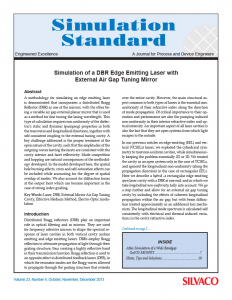Simulation of a DBR Edge Emitting Laser with External Air Gap Tuning Mirror
A methodology for simulating an edge emitting laser is demonstrated that incorporates a distributed Bragg Reflector (DBR) as one of the mirrors, with the other being a variable air gap external planar mirror that is used as a method for fine tuning the lasing wavelength. This type of calculation requires non uniformity of the dielectric’s static and dynamic (pumping) properties in both the transverse and longitudinal directions, together with self consistent coupling to the external tuning cavity. A key challenge addressed is the proper treatment of the open nature of the cavity, such that the amplitudes of the outgoing waves leaving the facets are consistent with the cavity interior and facet reflectivity. Mode competition and hopping are natural consequences of the methodology developed. In the model developed here, the spatial hole burning effects, cross and self-saturation effects can be included while accounting for the degree of spatial overlap of modes. We also account for diffraction losses at the output facet which can become important in the case of strong index guiding.
Key Words: Laser, DBR, External Mirror Air Gap Tuning Cavity, Effective Medium Method, Electro-Optic modulation
Introduction
Distributed Bragg reflectors (DBR) play an important role in optical filtering and as mirrors. They are used for frequency selective mirrors to shape the spectral response of laser cavities in both vertical cavity surface emitting and edge emitting lasers. DBRs employ Bragg reflection to attenuate propagation of light through their grating structure, thus creating a highly reflective band in their transmission function. Bragg reflection is used to an opposite effect in distributed feedback lasers (DFB), in which the resonator modes are the Bragg waves allowed to propagate through the grating structure that extends over the entire cavity. However, the main structural aspect common to both types of lasers is the essential non-uniformity of their refractive index along the direction of mode propagation. Of critical importance to their operation and performance are also the pumping induced non-uniformity in their interior refractive index and optical intensity. An important aspect of all laser cavities is also the fact that they are open systems from which light escapes to the outside.



